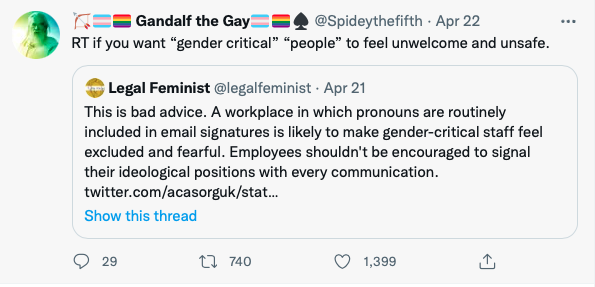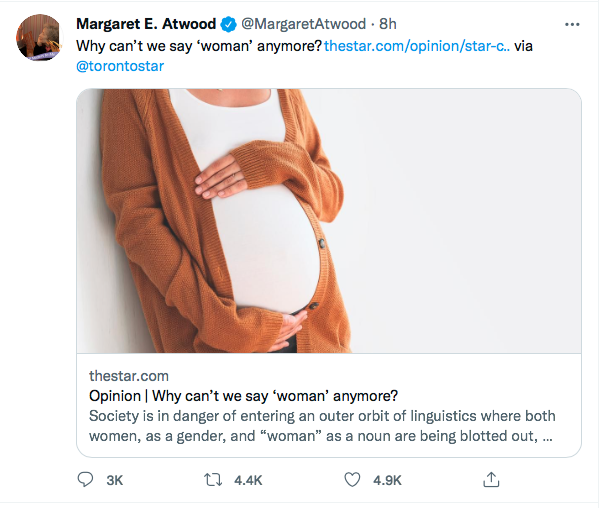How a false assumption led an employment tribunal to wrongly find an NHS Trust guilty of discrimination
A guest post by Anya Palmer, barrister
In a recent case, V v Sheffield Teaching Hospitals NHS Foundation Trust, the Leeds employment tribunal cleared the employer and several of its managers of a large number of claims of disability discrimination, gender reassignment discrimination, harassment and victimisation.
However, the tribunal concluded that the employer did discriminate against the Claimant when a manager asked the Claimant questions about removing his underwear at work.
In its judgment the tribunal describes the Claimant as “a transgender woman” and refers to him throughout as “she”. I will not be doing that, because in my view the use of this polite fiction directly led the tribunal to get the Claimant’s sex wrong and therefore to deploy the wrong comparison and get the law wrong.
We are told in the judgment that the Claimant was “currently transitioning”, but no information is given as to what that actually meant or how far the Claimant had got with it.
However, we are told that at the Claimant’s request, staff were told in writing that the Claimant would be joining their team, that the Claimant was transitioning from male to female and that he did not want to be asked questions about that. They were also told that the Claimant would be using a cubicle in the women’s changing rooms and did not want to be asked questions about that either.
It seems likely, therefore, that this was a case where it would be obvious to everyone that the Claimant was not a woman, and the Claimant’s colleagues were being warned that they should play along and not object or ask questions.
The judgment says the Claimant had been the victim of arson attacks outside work. Here is a BBC interview with a transgender person in Sheffield who was the target of an arson attack in 2019. It seems quite likely that “Amy” in this interview and the Claimant are the same person. The arson attack is appalling. But if this is indeed the Claimant, he does not (as of June 2020, about the same time as he started work for the Trust) remotely pass as female, and this is who the women were being told they had to share a changing room with and not ask questions.
The employer organised bespoke training on transgender and gender identity issues for everyone in the catering unit where the Claimant would be working. The tribunal notes that during the training some concerns were raised by female staff:
Some expressed concerns, mainly female members of staff worried about sharing the ladies changing room with a transgender woman. Mrs Edwards tried to address those concerns by explaining that there was no evidence of transgender women being a threat or causing any issues in the workplace, and that there needed to be a balance of rights and respect for someone who wanted to live her life completely as a woman.
We only have this third-hand description of how the women themselves expressed their concerns. It seems unlikely that the women expressed their concerns by referring to the claimant as a “transgender woman”. It is far more likely that they expressed concerns that they were being asked to share the women’s changing room with a man. But there are no findings on what the women themselves said.
What is clear is the women were not being asked if they agreed to the Claimant using the women’s changing room. They were being told that he could and would. Lip service was paid by the manager who delivered the training to a “balance of rights”, but it is clear that their right to any say in the matter had already been written off.
It is not clear why, because it is not the case in law that a trans-identified male at an early stage in their transition must be allowed to use the women’s facilities: see the Court of Appeal judgment in Croft v Royal Mail Group plc [2003] EWCA (Civ) 1045. But perhaps the Trust was taking advice from people who would not mention that case, who would advise that the Claimant must be treated as if he were a woman from the outset.
*****
The events that led to the finding of discrimination took place a year later. On 10 June 2021 the Claimant spoke to a Mrs Townsend, a Catering Assistant, asking to go home as he said he felt hot and sweaty and this was making him feel ill. He told her he was so hot he had taken his underwear off, and made a wringing motion with his hands.
Mrs Townsend went to see Mrs Hawkshaw, Catering Manager, because she herself did not have the authority to allow the Claimant to go home, and she recounted the whole conversation to Mrs Hawkshaw. She then made a note of the conversation.
In tribunal the Claimant denied making the remark or the gesture, but the tribunal preferred Mrs Townsend’s evidence:
137. … She had no issue with the Claimant and no reason to make this account up. She made a note of the conversation on the day. We found that it was accurate. It seemed to the Tribunal that the Claimant did have a tendency to blur appropriate boundaries, and perhaps to “overshare” with her colleagues. We noted that she denied making the comments and gesture as soon as she was asked about it a few days later, but we still found that it was more likely than not that the Claimant had made the comment and gesture.
The Claimant was then off work until 16 June 2021, when Mrs Hawkshaw held a return to work interview with the Claimant and told him he would have to attend a stage 3 attendance management meeting. The Claimant reacted very badly to this, going and shouting in front of staff and customers that he would take the Trust to court.
On 25 June 2021, Mrs Hawkshaw had another meeting with the Claimant to address various issues, and in this meeting she asked the Claimant about the underwear remark and the wringing gesture.
It seems that what moved Mrs Hawkshaw to ask questions about that now, two weeks after the Claimant had made the remark, was that the day before this meeting, Mrs Hawkshaw had received a report that the Claimant had been seen “naked from the waist down” in the women’s changing room. Mrs Hawkshaw had been given a statement about this. Unfortunately the tribunal does not tell us any more about this incident, which seems like it might just be relevant to why Mrs Hawkshaw questioned the Claimant about removing underwear at work, as indeed the tribunal itself concludes.
Mrs Hawkshaw did not ask the Claimant directly about the changing room allegation, but she did ask the Claimant in general terms whether he took his underwear off at work.
The Claimant found these questions embarrassing, and subsequently raised a grievance, and later brought a claim of direct discrimination based on gender reassignment in respect of having been asked them.
The tribunal dealt with this claim as follows:
152. …the Tribunal found that the Claimant had proved facts from which it could conclude, in the absence of an adequate explanation, that the reason Mrs Hawkshaw had asked her those questions about her underwear was because she is a transgender woman. Those facts were:
152.1 The questions asked were not simply about what had happened on 10 June 2021 but were more general questions about whether the Claimant wore or changed her underwear at work and whether she was ever inappropriately dressed at work.
….
152.4 Mrs Hawkshaw had received a report about the Claimant being naked from the waist down in the changing room before asking the questions. She did not mention that specifically, but the questions she asked seemed to be connected with that as much as with the conversation with Mrs Townsend.
152.5 A concern about the Claimant’s state of undress in the changing rooms was likely to be connected with the fact that she is a transgender woman. This was a communal changing room with a shower cubicle. It did not seem to the Tribunal likely that there would have been a concern about a cisgender woman in a state of undress while changing in such a changing room. [emphasis added]
153. The Tribunal therefore found that the burden shifted to the Trust to prove that the reason for Mrs Hawkshaw’s line of questioning was not the Claimant’s transgender status. The Trust did not do so…. The Tribunal therefore concluded that Mrs Hawkshaw asked the questions because of a concern that the Claimant as a transgender woman might be in a state of undress in the female changing room. That was because of gender reassignment. Mrs Hawkshaw would not have asked the questions of a cisgender woman. [emphasis added]
I will argue that this was the wrong comparator. To do so I first need to explain how comparisons work in discrimination law.
*****
To show that he or she has been discriminated against because of a protected characteristic, a claimant needs to show that he or she was treated less favourably than a comparator who does not have that protected characteristic.
So if you are a woman claiming sex discrimination, you need to show that a man was treated more favourably in the same (or not materially different) circumstances.
Or if there isn’t an actual comparator, you can argue (based on evidence) that a hypothetical man would have been treated more favourably in the same circumstances.
As a matter of logical inference, if a woman was treated less favourably than a man was treated (or a hypothetical man would have been treated) in the same circumstances, the reason for the less favourable treatment is the woman’s sex.
And so it goes for each of the nine characteristics that are protected under the Equality Act 2010: age, disability, gender reassignment, marriage and civil partnership, pregnancy and maternity, race, religion or belief, sex and sexual orientation.
The requirement that the circumstances must be the same, or not materially different, is an important feature of this comparison exercise. You have to compare like with like, and this is expressly stated in the Equality Act 2010 (and always has been since the Sex Discrimination Act 1975).
Section 23(1) of the Equality Act 2010 provides as follows:
(1) On a comparison of cases for the purposes of section 13, 14, or 19 there must be no material difference between the circumstances relating to each case.
Section 13 defines direct discrimination, so this requirement applies in any case where direct discrimination is claimed.
In Shamoon v Chief Constable of the RUC [2003] ICR 337 HL, the claimant, a senior police officer, brought a claim for sex discrimination, and she sought to compare how she had been treated by her line manager with how two male colleagues had been treated. The Northern Ireland Court of Appeal held that the two male officers were not valid comparators, because there was a material difference between her circumstances and theirs – there had been complaints about the Claimant, but not about the comparators. This was relevant to her line manager’s treatment of her. The House of Lords upheld that conclusion.
In the House of Lords, Lord Scott of Foscote explained the way that a comparison is used to establish direct discrimination, and he then said this:
110. In summary, the comparator required for the purpose of the statutory definition of discrimination must be a comparator in the same position in all material respects as the victim save only that he, or she, is not a member of the protected class. [emphasis added]
The way this applies in the case of a trans-identified male who has not obtained a Gender Recognition Certificate (GRC) was confirmed by the High Court in R (on the application of Green) v Secretary of State for Justice.
The claimant, a male prisoner serving a life sentence for murdering his wife, had recently decided he wanted to undergo gender reassignment, and he sought judicial review because he was refused permission to obtain “wigs, intimate prostheses and tights” (for security reasons). The claimant complained that this was in breach of prison service policy, and also complained that it was unlawful discrimination contrary to the Equality Act.
The judge dealt with the discrimination part of the claim as follows:
65. This is a direct discrimination claim under section 13(1) of the Equality Act 2010 and, as the Governor is exercising a public function, section 29(6) engages.
66. A comparator has to be found in order for there to be discrimination or for the claimant to show she has had less favourable treatment. The claimant asserts the comparator should be a female prisoner; whereas the governor contends it should be a male prisoner. There can be no doubt the claimant has a protected characteristic — gender reassignment. The claimant is, however, male. The only possible comparator is to a male prisoner who is not undergoing gender reassignment.
67. It seems to me that I must approach the discrimination issues in this way:
(1) Has the claimant been treated less favourably by the Governor than he would treat others in the exercise of his public function?
(2) If he has so treated the claimant, was this due to the claimant’s gender reassignment?
68. Frankly, it is almost beyond argument that the only comparator is a male Category B prisoner at HMP Frankland. I am influenced by the judgment of the Court of Appeal in Croft v Royal Mail Group plc [2003] EWCA (Civ) 1045. I find it impossible to see how a female prisoner can be regarded as the appropriate comparator. The claimant is a man seeking to become a woman — but he is still of the male gender and a male prisoner. He is in a male prison and until there is a Gender Recognition Certificate, he remains male. A woman prisoner cannot conceivably be the comparator as the woman prisoner has (either by birth or election) achieved what the claimant wishes. Male to female transsexuals are not automatically entitled to the same treatment as women — until they become women.
69. A male prisoner (who wishes to remain male as most do) does not need to express his gender identity in any purposeful way. He does so innately through the male clothes he wears and certainly does so via prison clothing. Transsexual prisoners are treated differently (and wish to be so) and as such have a number of advantages in terms of clothing and lifestyle not available to the remainder of the male prison population absent privileges.
70. I have no hesitation in saying the correct comparator is a male prisoner in Category B at HMP Frankland. I am utterly unconvinced that the claimant has been treated less favourably than such a prisoner — indeed the reverse. Consequently, the second question I posed does not arise.
In short: the correct comparator for a trans-identified male who does not have a GRC, and is claiming gender reassignment discrimination, is a male who does not identify as trans.
The correct comparator is a person who does not have the protected characteristic of gender reassignment. But the comparator should be the same in all other material respects. So if the claimant is male, the comparator must also be male.
*****
How do we apply Shamoon and Green to the facts in V v Sheffield Teaching Hospitals?
The Claimant in V was not a woman, however managers and the tribunal refer to him. He was born male. He remained male. The fact that he now identified as “a transgender woman” did not change this. Self ID is not yet the law in this country, however much Stonewall and others try to make out that is the case.
The judgment does not say whether the Claimant had obtained a GRC, but if he had obtained one it seems likely that he would have mentioned that in evidence and relied on it, that the tribunal in turn would mention that in its fact finding, and indeed the tribunal might have considered in its reasoning what effect, if any, that had when making the comparison.
So it seems highly likely that the Claimant did not have a GRC and remained legally male, as well as biologically male.
The correct comparator would therefore be a male who did not have the protected characteristic of gender reassignment.
So why did the tribunal draw a comparison between how the Claimant was treated and how a “cisgender woman” would have been treated?
There are two possibilities here:
(1) The tribunal did not understand that the comparator should be the same as the Claimant in all respects except for the protected characteristic, and so the comparator should be of the same sex as the Claimant; or
(2) The tribunal wrongly assumed that the Claimant was female, and therefore concluded the comparator should be female.
The tribunal does not give any explanation as to how it decided that the correct comparator was a “cisgender woman”, so it’s difficult to say for sure which of the above is the answer, but I strongly suspect the answer is (2).
The tribunal is very likely to have considered the Equal Treatment Bench Book (ETBB). This is a sort of diversity and inclusion handbook for the judiciary. It provides guidance on how to run the hearing. It is not a guide to the law. It has no status in law. And yet it is highly influential. It advises courts and tribunals to always use a trans person’s chosen name and pronouns regardless of the reality or their legal status:
It should be possible to respect a person’s gender identity and their present name for nearly all court and tribunal purposes, regardless of whether they have obtained legal recognition of their gender by way of a Gender Recognition Certificate.
In other words – the court or tribunal is advised to be guided by self ID. If a male person says he identifies as a woman, then regardless of whether he has obtained a GRC, regardless whether he has even undergone any physical transition, the court should refer to him as a woman and use the pronouns “she” and “her.”
It’s the same advice that the Trust gave to its employees. Act like V is a woman. Don’t ask questions.
Trans women are women.
The problem is that this is, essentially, a political position which does not represent the law anywhere in the UK. Self ID is not the law. But the idea that a man is a woman if he says so is being pushed by activists to managers and decision makers in institutions up and down the land. It is happening in the NHS. And it is happening in the judiciary. (For a full analysis of the problems with the Equal Treatment Bench Book in this respect, see Prejudging the Transgender Controversy by barrister Thomas Chacko.)
There is no reminder to the judges who consult the Equal Treatment Bench Book that there may be cases in which it falls to them, as part of their job, to consider what sex the claimant is, and at that point they need to forget about polite fictions and determine whether the claimant, as a matter of fact and law, is a man or a woman – however unpalatable it may be to the claimant if the answer is that the claimant is male.
(Nor is there any warning to counsel that the judge may consult the ETBB. In the preliminary hearing in Forstater v CGD Europe on whether the claimant’s belief was a protected belief, I was not aware that the employment judge had consulted the ETBB until I read about that in the judgment. I had no opportunity to address the judge on that. Obviously this should not have happened, but happen it did. By way of advice to any counsel dealing with these cases – be aware that the judge may consult the ETBB without telling you. If there is anything you want to say about the ETBB, make sure you say it. Don’t wait to be asked.)
I suspect the tribunal in this case did as it was told by the ETBB (and/or any diversity training the judge may have had) and referred to the claimant throughout as “a transgender woman” and using the pronouns “she” and “her”. And in doing so it forgot that this polite fiction did not mean the claimant was in fact a woman.
So when it came to look for a non-transgender comparator, it assumed the comparator would be a non-transgender woman.
*****
How did this affect the tribunal’s conclusions on this issue?
The tribunal concluded that
152. … the Tribunal found that the Claimant had proved facts from which it could conclude, in the absence of an adequate explanation, that the reason Mrs Hawkshaw had asked her those questions about her underwear was because she is a transgender woman... [emphasis added]
152.4 Mrs Hawkshaw had received a report about the Claimant being naked from the waist down in the changing room before asking the questions. She did not mention that specifically, but the questions she asked seemed to be connected with that as much as with the conversation with Mrs Townsend.
152.5 A concern about the Claimant’s state of undress in the changing rooms was likely to be connected with the fact that she is a transgender woman. This was a communal changing room with a shower cubicle. It did not seem to the Tribunal likely that there would have been a concern about a cisgender woman in a state of undress while changing in such a changing room. [emphasis added]
153. The Tribunal therefore found that the burden shifted to the Trust to prove that the reason for Mrs Hawkshaw’s line of questioning was not the Claimant’s transgender status.
The flaw in the tribunal’s reasoning is obvious once we consider the question the tribunal should have asked:
Was Mrs Hawkshaw likely to have been concerned about a non-transgender male in a state of undress while using the women’s changing room?
Well of course she would. Because it was a women’s changing room, and the non-trans male comparator is… male.
(One could posit as part of the relevant circumstances for making this comparison, that the comparison should be with a non-transgender man who, for some exceptional reason, had been given permission to use the women’s changing room. Even so, it is obvious that if that man were then seen “naked from the waist down” by women using the changing room, that would have been reported to Mrs Hawkshaw, and she in turn would have had concerns, especially if she knew that he had also, on an earlier occasion, told a female supervisor that he was so hot he had removed his underwear, and had made a wringing motion.)
If the correct comparison is used, I cannot see how the tribunal would have concluded that the burden shifted to the Respondent to explain the difference in treatment. There is no difference in treatment once the proper comparator is used. Any report of a man making comments to female colleagues about removing his underwear and then seen naked from the waist down in the women’s changing room would have given rise to the same concern.
The respondent NHS Trust therefore has, in my view, a clear ground of appeal in respect of the one finding of gender reassignment discrimination made against it.
I hope the Trust will appeal. It is only by challenging decisions like this one on appeal that tribunals will hopefully learn to think through what does and does not properly constitute gender reassignment discrimination.





